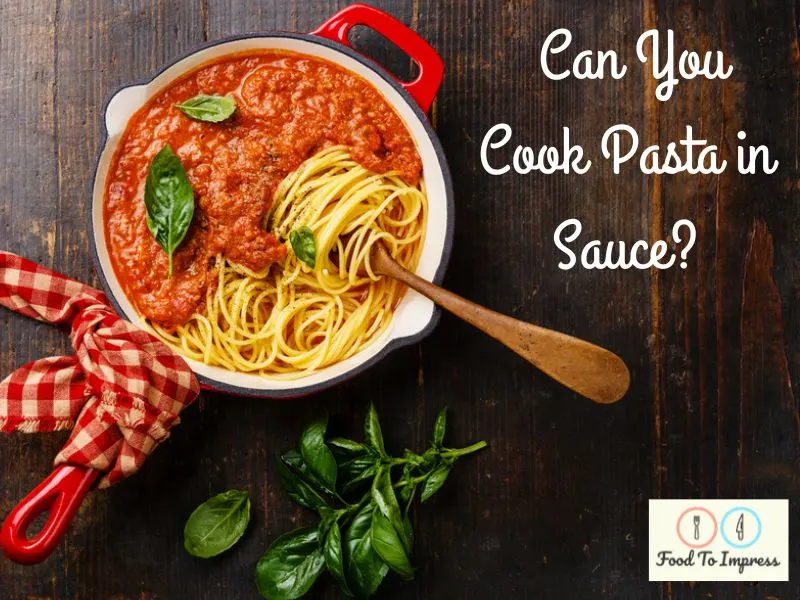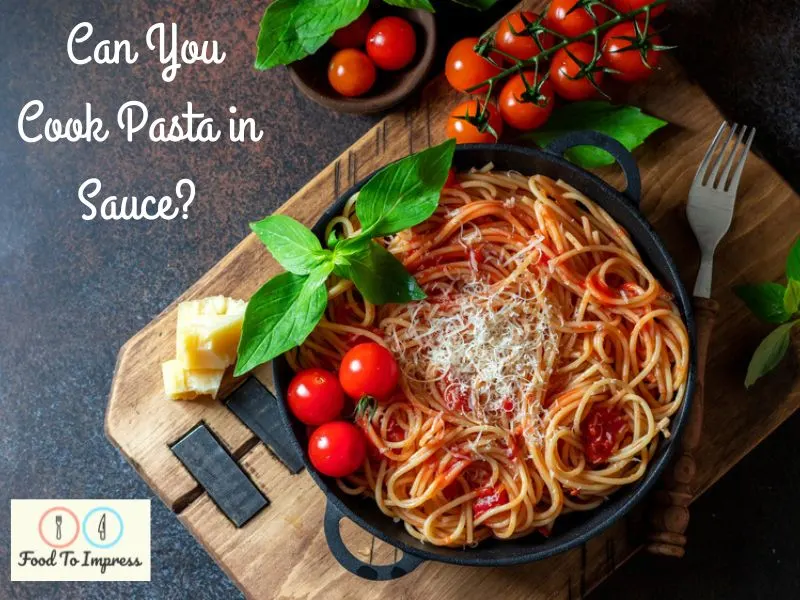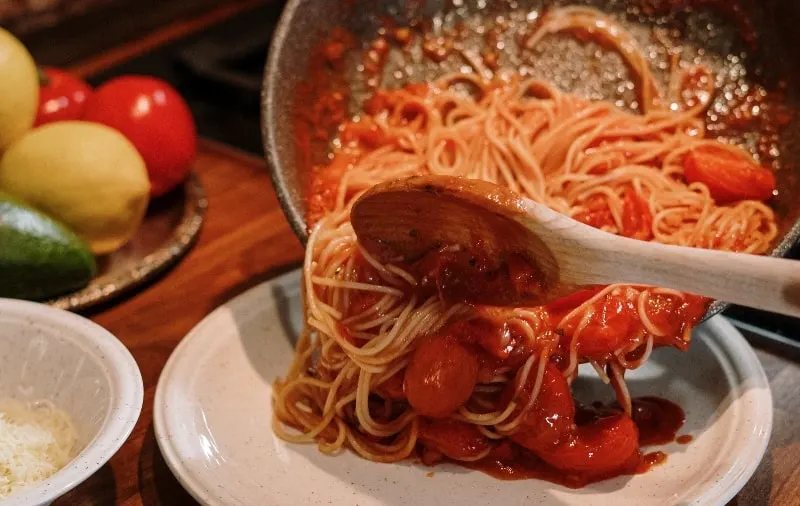We all know how to cook pasta, right? You get a pot of boiling water, add your dried pasta, and cook for 8-12 minutes. It’s pretty easy once you know what you’re doing and it’s the standard way to cook dried pasta, but are there other ways to cook it? Fortunately, there is another unique, non-traditional way you can cook your pasta. Are you curious to see can you cook pasta in sauce?
Like many people, you might have been boiling pasta in a large pan of water and wondered whether you can cook that pasta in the sauce instead. Well, I’m here to answer that for you.
You can cook pasta in the sauce, but you need to make sure that you’re adding more liquid for the pasta to absorb. To do this, dilute the sauce until it covers the dry pasta, then continue to add more liquid whenever the pasta dries out. This leaves you with a creamy sauce and fewer pans to clean.

Cooking Pasta in Sauce
Pasta is cooked primarily in boiling water because it absorbs a lot of water and releases starch. This is the most traditional and easiest way to do cook it. Pasta that’s cooked in the sauce requires the sauce the be watered down (since the pasta absorbs a lot of water) and it will take longer to cook. Another thing to consider is that since it releases starch directly into the sauce, it will thicken it more.
Although both methods can give you tasty results, they are still different and therefore produce different results, so it’s down to you to decide which one you prefer.
How Cooking Pasta In Sauce Differs To Boiling
Cooking pasta in sauce is absolutely different from cooking it in boiling water and the results will show that. This definitely isn’t to say that the results you get from either will be bad though. When pasta is cooked in the sauce properly, it’s still good.
Let’s take a quick look at the two main ways these cooking methods differ.
The Method
The first and most obvious way these two differ is simply in the way they’re made. Obviously, cooking your pasta in the sauce is very different from boiling it in plain water. When cooking with water alone, you can add as much water to the pot as you want without ruining it, but it’s a different story when cooking it in the sauce.
When you’re cooking the pasta in the sauce, you need to ensure that the sauce is at the perfect consistency by the time the pasta is perfectly cooked, but this isn’t easy.
To get this right, you need to add enough extra liquid for the pasta to absorb whilst not making it too watery. Too little water and both the pasta and pasta sauce will be dry, but too much water and everything will be too wet, like a saucy pasta soup. It’s about finding a balance. Fortunately, cooking pasta in the sauce isn’t that difficult once you get the hang of it.
Another thing to consider is the salt level of your sauce. You may need to add slightly more salt to the pasta in order to make up for not boiling it in salted water. You want to do this so you’re making sure that you’re seasoning both the sauce and the pasta directly.

The Results of Cooking Pasta in Sauce
The results you’ll get from these these two methods will be noticably difference, primarily due to the amount of starch.
When boiling pasta, you allow it to release a lot of its starch into the pasta water. The pasta can then be removed and added directly to the sauce, without excess starch (many cooks still add some of the starchy pasta water to the sauce). This allows you to control the amount of starch you get.
When cooking the pasta in the sauce, starch will be released directly into it, which means that you can’t control how much starch goes into the sauce. All that starch can cause the sauce to become thicker than you’d like, but it’s not a huge problem since you can just add more liquid.
This starch is great for getting the sauce to stick to the pasta, so you’ll never have to worry about getting an unsauced piece of pasta with this method. Your pasta should be less sticky.
In summary, cooking pasta in the sauce will lead to it becoming thicker, slightly altering the flavor, and allowing the sauce to adhere to each piece of pasta.
When You Shouldn’t Cook Pasta In The Sauce
Since you can cook most pasta dishes in the sauce (e.g pasta bake, lasagna, one-pot meals, and more), it’s better for us to look at when you generally can’t/shouldn’t cook the pasta in the sauce.
- If It’s Long Pasta
Unless you have a very tall and wide pot, cooking long, dried pasta, like spaghetti or linguine, in the sauce won’t work particularly well. It’s almost impossible to cook in any normal saucepan without having most of it sticking out of the pot, which leads to it being very unevenly cooked by the time the full length of the pasta has softened.
The only effective way to cook long pasta is to break it in half, or in thirds, but that ruins the fun of having long pasta. - When You Want Pasta Fast
Cooking pasta in the sauce takes more time than boiling it in water alone. You don’t want to boil the sauce either – that’d just make a mess.
Since it takes longer, you shouldn’t try and make it if you’re looking for a quick meal. If you’ve got less than 30 minutes (not that it always takes that long), you should boil the pasta in water and coat it in a pre-made sauce and you’ll have it in about 15 minutes. - If A ‘Starchy’ Taste Bothers You
If you’re wanting a perfect pasta dish, cooking it in the sauce isn’t the way to go.
Since the pasta releases that starch into the sauce, you’re most likely going to know it’s there. Although starch isn’t generally noticeable, having a lot of it will leave the dish with a different taste compared to normal.
Some people don’t mind this starchy flavor, but you should avoid this method if you don’t like tasting some starch.
Is It Better To Boil The Pasta Or Cook It In The Sauce?
So, you now know that you can also cook pasta in the sauce, and the results you get from both boiling and cooking in the sauce are different, but is it really worth it to cook the pasta in the sauce, or is it better to boil it in water?
Suppose we’re talking about which method is better overall. In that case, I personally have to say that boiling it in water alone is best purely because it rids the pasta of the unnecessary extra starch. This isn’t to say that cooking it in the sauce doesn’t still give tasty results though.
Another reason that it’s better is that it’s quicker. In water, dried pasta cooks in 8-12 minutes (depending on the size) and can be on the plate within 15 minutes, assuming the sauce is done. When it’s done in the sauce, it can take much longer to cook through.
The downside to boiling it is that you have to use another pan, which means a bit more cleaning up after cooking, but it’s not terrible since you’re only left with a pan full of starchy water.
My favorite way to cook pasta is to boil it in water up until it’s a few minutes away from being al dente, then I’ll throw it in the pasta sauce with some reserved pasta water to finish cooking. This allows me to get the best of both methods and control how much starch I add to the sauce. This leads to a smooth sauce that sticks to your perfectly cooked pasta. Try it out next time you make pasta and see how you like it.
At the end of the day, if you want to cook the pasta in the sauce for the purpose of making your life easier, then by all means do so. You can still get great results, but you should keep in mind that you need to add more water whenever the pasta starts to look dry. Do this until the pasta is al dente and the sauce is to your desired consistency.
If you have leftover spaghetti, remember you can freeze it too!

